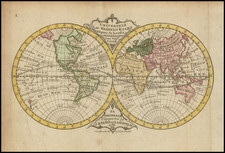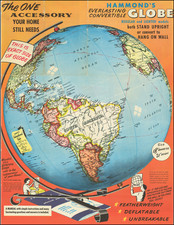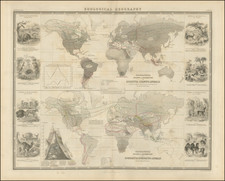This scarce double hemisphere map of the world is one of the earliest maps to show a representation of the Sea or Bay of the West. The map is a marvelous depiction of the routes of a number of important explorers, showing the routes of Magellan (1520), Le Maire (1615), St. Louis (1708), Halley (1700), Mendanna (1595), Antoine, (1710), Tasman (1642), Quiras (1605). The map shows a small bit of the areas explored by the Russians on the west coast of North America, suspended in the middle of the Bering Sea, without further connection to the land. It apparently was derived from the earliest reports of J.N. De L'Isle back to Paris, from his stay in St. Petersburg. Interesting incomplete New Zealand, mythical hint of the unknown Southern Continent and incomplete coast of Nouvelle Hollande (Australia).
Johannes Covens (1697-1774) was a Dutch geographic publisher based in Amsterdam. He is best known for his collaboration with fellow publisher Cornelis Mortier (1699-1783). Pierre Mortier the Elder (1661-1711) had obtained a privilege in 1690 to distribute the works of French geographers in the Netherlands. After his widow continued the business for several years, Cornelis took over in 1719.
In 1721, Mortier forged a partnership with Covens, who had recently married Cornelis’ sister. They published under the joint name of Covens & Mortier. In 1774, upon the death of his father, Johannes Covens II (1722-1794) took over his father’s share. In 1778, the company changed its name to J. Covens & Zoon, or J. Covens & son.
Covens II’s son, Cornelis (1764-1825), later inherited the business and brought Petrus Mortier IV back into the fold. Petrus was the great-grandson of Petrus Mortier I. From 1794, the business was called Mortier, Covens & Zoon, or Mortier, Covens, & Son.
The business specialized in publishing French geographers including Deslisle, Jaillot, and Sanson. They also published atlases, for example a 1725 reissue of Frederik de Wit’s Atlas Major and an atlas, with additions, from the works of Guillaume Delisle. There were also Covens & Mortier pocket atlases and town atlases. The company profited from acquiring plates from other geographers as well. For example, the purchased Pieter van der Aa’s plates in 1730. Finally, they also compiled a few maps in house. At their height, they had the largest collection of geographic prints ever assembled in Amsterdam.
Cornelis Mortier (1699-1783) was a Dutch publisher who specialized in geography. Cornelis’ father, Pierre Mortier the Elder (1661-1711), had obtained a privilege in 1690 to distribute the works of French geographers in the Netherlands. After his widow continued the business for several years, Cornelis took over in 1719.
In 1721, Mortier forged a partnership with Johannes Covens, who had recently married Cornelis’ sister. They published under the joint name of Covens & Mortier. Their firm was one of the largest and most successful in Dutch history and continued in business until the late-nineteenth century.
In 1774, upon the death of his father, Johannes Covens II (1722-1794) took over his father’s share. In 1778, the company changed its name to J. Covens & Zoon, or J. Covens & Son. Covens II’s son, Cornelis (1764-1825), later inherited the business and brought Petrus Mortier IV back into the fold. Petrus was the great-grandson of Petrus Mortier I. From 1794, the business was called Mortier, Covens & Zoon, or Mortier, Covens, & Son.
The business specialized in publishing French geographers including Deslisle, Jaillot, and Sanson. They also published atlases, for example a 1725 reissue of Frederik de Wit’s Atlas Major and an atlas, with additions, from the works of Guillaume Delisle. There were also Covens & Mortier pocket atlases and town atlases. The company profited from acquiring plates from other geographers as well. For example, the purchased Pieter van der Aa’s plates in 1730. Finally, they also compiled a few maps in house. At their height, they had the largest collection of geographic prints ever assembled in Amsterdam.









![Charte über die verschiedenen jezt auf der Erde herrschenden Religionen [Map on the various religions now ruling the earth]](https://storage.googleapis.com/raremaps/img/small/85202.jpg)

![[ Map Game Board ] Wallis's New Game, exhibiting a Voyage round the World.](https://storage.googleapis.com/raremaps/img/small/98593.jpg)


![Hemisphere Occidental ou du Nouveau Monde . . . [and] Hemisphere Oriental ou de L'Ancien Monde . . . MDCCLXI](https://storage.googleapis.com/raremaps/img/small/64273.jpg)